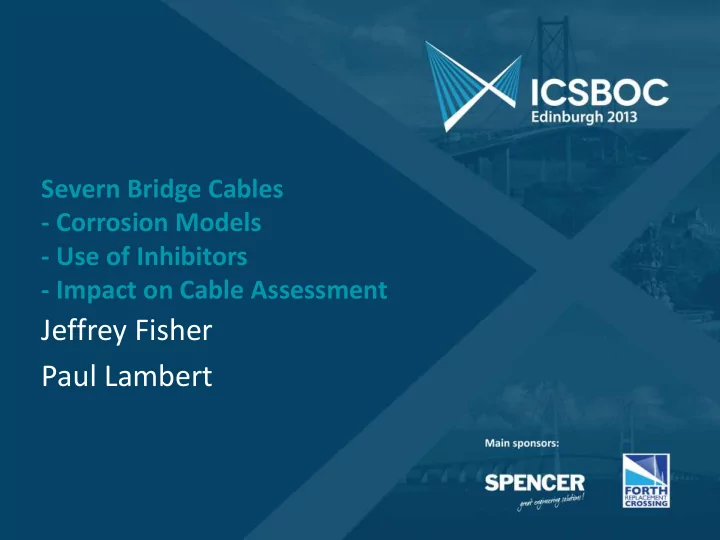

Severn Bridge Cables - Corrosion Models - Use of Inhibitors - Impact on Cable Assessment Jeffrey Fisher Paul Lambert
Background and History Corrosion Modelling Effect of RH on Corrosion Rate Corrosion Inhibitors Laboratory & Site Testing of Inhibitors Monitoring of Cable Results of Acoustic Emission Monitoring Conclusions
Background & History Key Facts Main span - 987.55m Sag/Span - 1/12 Diameter of Cable - 495mm No. of wires in each cable (4.98mm dia) - 8322 Opened – September 1966
Cable Works - Timeline 2005 – Mott MacDonald commence cable investigation 2006 - 1 st intrusive inspection of cable (Faber Maunsell) 2006 – Monitoring of traffic using WIM sensors 2006/2008 – Installation of acoustic sensors 2008/2009 – Dry air injection system installed 2010 – 2 nd intrusive inspection of cable (Aecom)
Corrosion
Corrosion Modelling Probability Density Function of Depth of Penetration 25 years after coating breakdown, actual and predicted 3000 Depth of Penetration (microns) 2500 2000 Zinc prediction Iron Prediction Actual Penetration Recorded 1500 1000 500 0 0% 10% 20% 30% 40% 50% 60% 70% 80% 90% 100% Cumulative Frequency%
Effect of RH on Corrosion Rate (Vernon, 1935)
Effect of RH on Corrosion Rate Reducing relative humidity has long been recognised as an effective method of controlling corrosion The method is effective as long as the system is working but what happens if it is off for servicing or fails? Also, during the draw- down from ‘saturated’ to ‘dry’ there may be an extended period of ‘damp’ when corrosion may accelerate A method of introducing a secondary protection system was therefore investigated, based on the use of mobile, adherent organic corrosion inhibitors
Corrosion Inhibitors A corrosion inhibitor is essentially any material that when introduced to an environment where corrosion is anticipated or already occurring will either result in a significant reduction in existing corrosion or prevent low rates of corrosion from increasing For practical reasons, this generic definition should be appended by the requirement for the inhibitor to be effective at relatively low levels of application
Corrosion Inhibitors – Three Types Anodic Inhibitor - typically oxidising agents such as nitrites, impede the progress of the anodic reaction Cathodic Inhibitor - generally involves limiting the cathodic reaction by removing oxygen Mixed Inhibitor - usually volatile film formers that deposit a thin continuous layer, one or two molecules thick over the entire surface of the metal
VPCI Testing of Wrap and Sealants
VPCI Effect on Tensile Strength of Wrap
VPCI Effect on Inter-Wire Friction
On Site Inhibitor Testing
On Site Inhibitor Testing Inhibitor No Inhibitor
Corrosion Monitoring In order to confirm the effectiveness of the combined RH/inhibitor system, air from the outlet ports is monitored for its ability to sustain corrosion The corrosion rate should remain within the range: – 0.1 – 1 µA/cm 2 , which is approximately equivalent to 1 – 10 microns per year, or – 0.04 to 0.4 mils per year The probes work by measuring small changes in resistance of a tubular steel specimen corrodes – they do not measure the corrosion rate of the wires directly Testing of removed probes confirms the presence of inhibitor on the surface of the steel tube
Corrosion Monitoring Probe
Monitoring of Cable Substandard element of the structure Reviewed in accordance with BD 79 Monitoring procedure implemented that provides stakeholders with a reasonable level of confidence
Monitoring Plan Visual Observations – during cable inspections Traffic Loading – WIM sensors allow a BSALL to be undertaken – Results of BSALL over last 7 years show little change in traffic loading and mix Acoustic Monitoring – Provides indication of wire breaks Dry Air Injection Monitoring – Controls atmosphere within cable – RH less than 40% - no corrosion
Acoustic Monitoring (1)
Acoustic Monitoring (2) Emissions before dry air – 0.4% of total wires Emissions during cable drying out period about 15 breaks per year – 0.1% per year Emissions after drying out less than 10% of emission before dry air
Conclusion Stabilised condition of cable – by installation of dry air injection and use of vapour phase inhibitor Demonstrated by reduction of relative humidity and low levels of acoustic emissions Site testing for corrosion inhibitors demonstrated effectiveness of dry air system
Recommend
More recommend